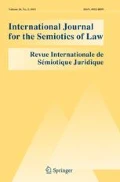Abstract
The centrality of argumentation in the judicial process is an age-old acquisition of research on legal discourse. Notwithstanding the deep insights provided by legal theoretical and philosophical works, only recently has judicial argumentation been tackled in its linguistic dimension. This paper aims to contribute to the development of linguistic studies of judicial argumentation, by shedding light on evaluation as a prominent aspect in the construction of the judge’s argumentative position. Evaluation as a deep structure of judicial argumentation is studied from a discursive point of view entailing the analysis of a sample of authentic judicial language. Evaluative lexis is investigated within a single genre of judicial discourse, i.e. judgments, instantiated by a corpus of US Supreme Court judgments. Findings show that judges use diversified strategies to take stance as they organise their argumentative discourse: from easily recognisable verbal and adjectival tools to more finely-grained discourse elements such as the encapsulating pattern ‘this/these/that/those + labelling noun’.
Similar content being viewed by others
Notes
Only case Rita v. United States (21 June 2007) could not be included in the corpus, since the hypertextual link to it did not work.
Concordance is one of the main on-screen functions provided by Wordsmith Tools 3.0. By typing in the desired word/phrase, the function provides the analyst with an all-inclusive list of corpus occurrences of the word/phrase in context.
The use of italics as well as underscoring in examples signals my own focus of analysis. In particular, italicised items emphasise elements related to those of interest in the analytical discussion, whereas underlined items are those on which the study centres.
In Table 1, the heading ‘Pattern occurrences’ refers to the frequency of the lemma as embedded in the pattern ‘this/these/that/those + labelling noun’ discussed in this section.
References
Perelman, Chaïm, and Lucie Olbrechts-Tyteca. 1958. Traité de l’argumentation. La nouvelle rhétorique. Bruxelles: Editions de l’Université de Bruxelles.
Bobbio, Norberto. 1966. Preface to the Italian Edition of the Traité de l’Argumentation [1958]. In Trattato dell’argomentazione. La nuova retorica, ed. Chaïm Perelman and Lucie Olbrechts-Tyteca. Torino: Einaudi.
Perelman, Chaïm. 1980. Justice, law and argument. Dordrecht: Reidel.
Goodrich, Peter. 1986. Reading the law: A critical introduction to legal method and techniques. Oxford: Blackwell.
Alexy, Robert. 1989. A theory of legal argumentation: The theory of rational discourse as theory of legal justification. Oxford: Clarendon Press.
Peczenik, Alexander. 1989. On law and reason. Dordrecht: Kluwer.
Kalinowski, Georges. 1965. Introduction à la logique juridique. Paris: Librairie Générale de Droit et de Jurisprudence.
Mathieu-Izorche, Marie-Laure. 2001. Le raisonnement juridique. Initiation à la logique et à l’argumentation. Paris: Presses Universitaires de France.
Vannier, Guillaume. 2001. Argumentation et droit. Introduction à la nouvelle rhétorique de Perelman. Paris: Presses Universitaires de France.
MacCormick, Neil, and Robert S. Summers. 1991. Interpreting statutes. Aldershot: Dartmouth.
MacCormick, Neil, and Aulis Aarnio (eds.). 1992. Legal reasoning. Aldershot: Dartmouth.
MacCormick, Neil, and Robert S. Summers (eds.). 1997. Interpreting precedents. A comparative study. Aldershot: Dartmouth.
Bourcier, Danièle, and Sylvie Bruxelles. 1995. Une approche sémantique de l’argumentation juridique. Dire et C’est-à-dire. Revue Française de Sociologie 36: 35.
Mortara Garavelli, Bice. 2001. Le parole e la giustizia. Divagazioni grammaticali e retoriche sui testi giuridici italiani. Torino: Einaudi.
Nivelle, Nele, and William Van Belle. 2007. The use of counterfactual conditionals expressing causation in legal discourse. In Proceedings of the Sixth Conference of the International Society for the Study of Argumentation, eds. Frans H. van Eemeren, J. Anthony Blair, Charles A. Willard and Bart Garssen, 989–996. Amsterdam: SicSat.
Goodrich, Peter. 1987. Legal discourse. London: MacMillan.
Hunston, Susan, and Geoff Thompson. 2000. Evaluation: An introduction. In Evaluation in text. Authorial stance and the construction of discourse, ed. Susan Hunston, and Geoff Thompson, 1–27. Oxford: Oxford University Press.
Bhatia, Vijay. 2004. Worlds of written discourse. A genre-based view. London: Continuum.
Swales, John. 1990. Genre analysis. English in academic and research settings. Cambridge: Cambridge University Press.
Bowker, Lynne, and Jennifer Pearson. 2002. Working with specialized language. A practical guide to using corpora. London: Routledge.
Scott, Mike. 1998. Wordsmith tools 3.0. Oxford: Oxford University Press.
Flowerdew, John. 2003. Signalling nouns in discourse. English for Specific Purposes 22: 329.
Sinclair, John. 1993. Written discourse structure. In Techniques of description. Spoken and written discourse, ed. John Sinclair, Michael Hoey, and Gwyneth Fox, 6–31. London: Longman.
Sinclair, John. 1996. The search for units of meaning. Textus 9: 75.
Sinclair, John. 2004. Trust the text. Language, corpus and discourse. London: Routledge.
Bhatia, Vijay. 1993. Analysing genre: Language use in professional settings. London: Longman.
Stati, Sorin. 2002. Principi di Analisi Argomentativa. Bologna: Pàtron.
Stubbs, Michael. 2001. Words and phrases: Corpus studies on lexical semantics. Oxford: Blackwell.
Malavasi, Donatella. 2007. Promotion in banks’ annual reports. Modena: Il Fiorino.
Scarpelli, Uberto. 1985. Contributo alla semantica del linguaggio normativo. Milan: Giuffrè.
Greimas, Algirdas J. 1987. On meaning. Minneapolis: University of Minnesota Press.
Jackson, Bernard. 1988. Law, fact and narrative coherence. Roby: Deborah Charles Publications.
Morrison, Mary J. 1989. Excursions into legal language. In Law and language, ed. Frederick Schauer 1993, 271–336. Aldershot: Dartmouth.
Jackson, Bernard. 1985. Semiotics and legal theory. London: Routledge.
Author information
Authors and Affiliations
Corresponding author
Rights and permissions
About this article
Cite this article
Mazzi, D. “This Argument Fails for Two Reasons…”: A Linguistic Analysis of Judicial Evaluation Strategies in US Supreme Court Judgments. Int J Semiot Law 23, 373–385 (2010). https://doi.org/10.1007/s11196-010-9162-0
Published:
Issue Date:
DOI: https://doi.org/10.1007/s11196-010-9162-0




